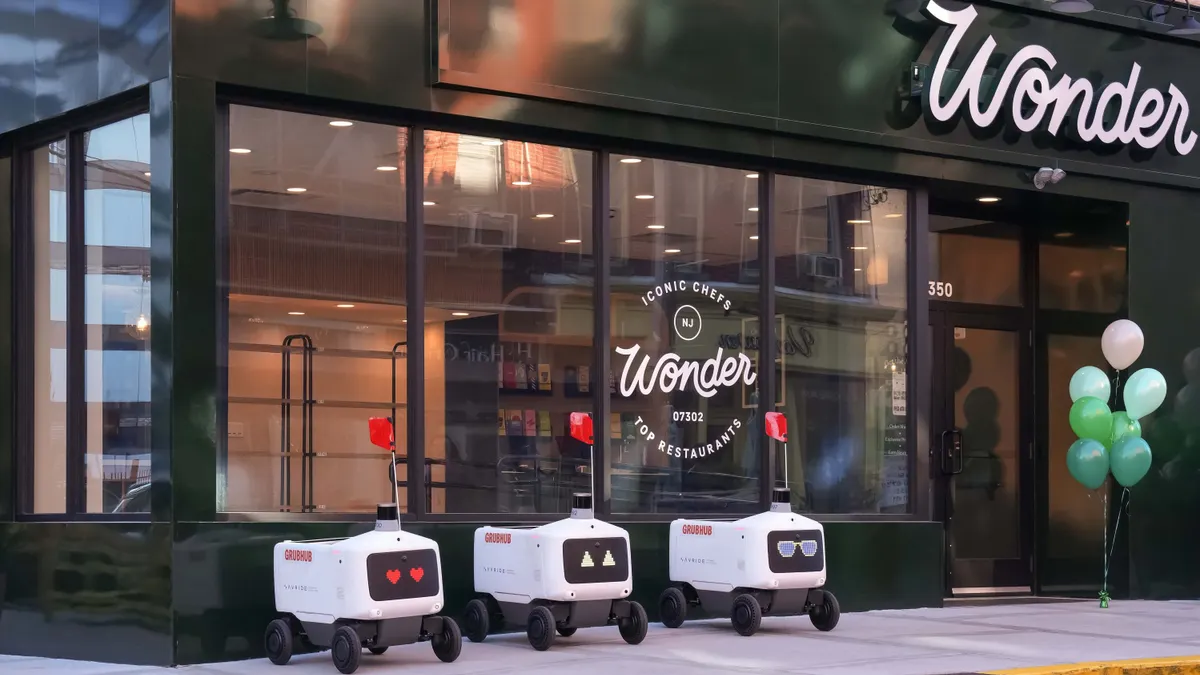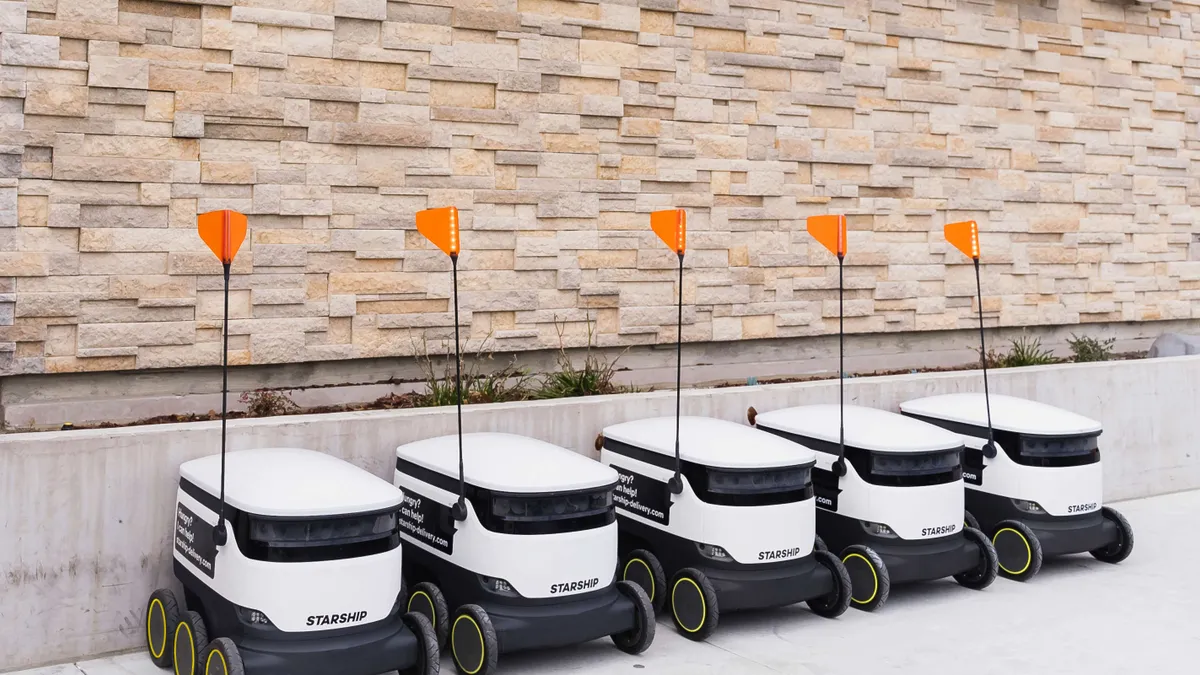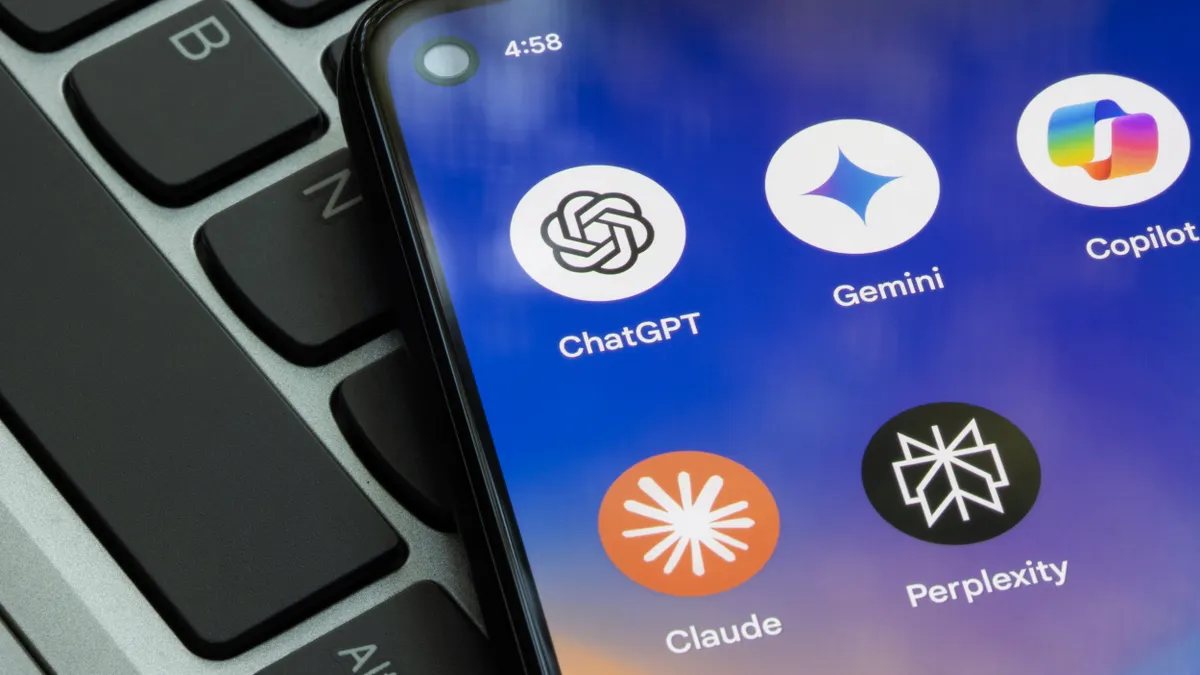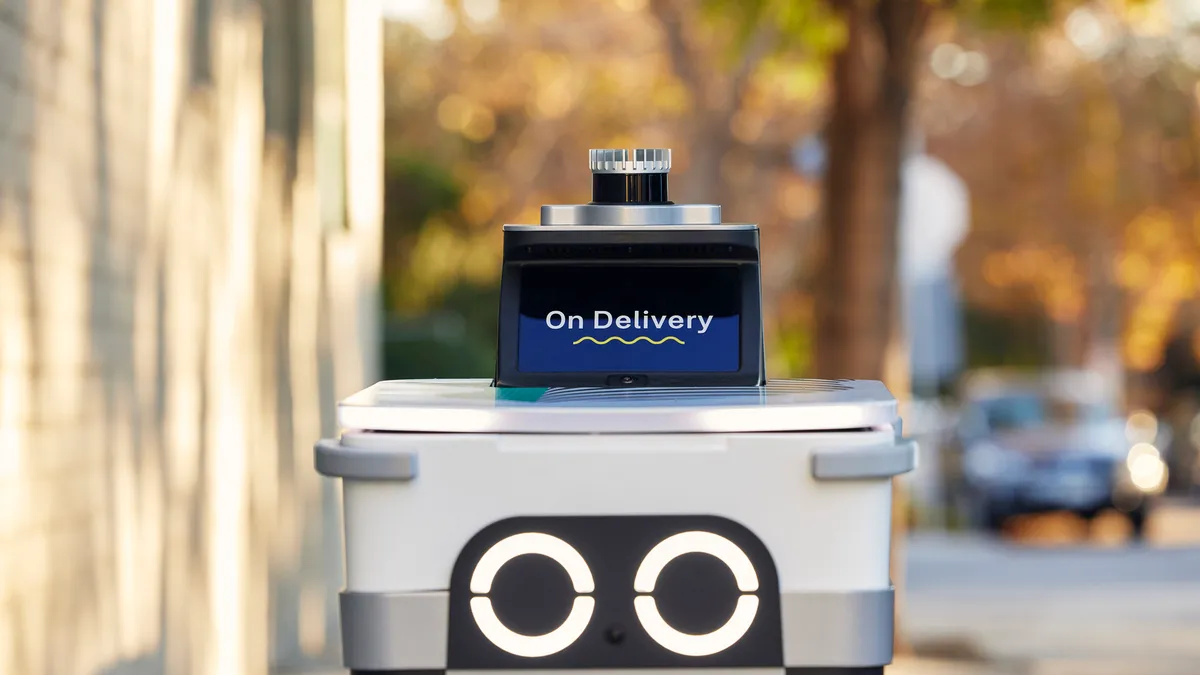To meet customers where they are, restaurants have been all but forced to embrace online ordering for pickup and delivery. While major brands including Chipotle, Panera and Roti have added second lines to accommodate the influx of carryout orders, other brands and third-party platforms have turned to an entirely new model: the virtual restaurant.
Also known as "ghost kitchens" or "headless restaurants," these businesses don't employ a robust front-of-house staff. They don't have seating. They don’t really have a storefront. They exist solely online, on the apps and websites of aggregate delivery services. In many cases, these restaurants don't have a web presence outside their page on platforms like Grubhub or Uber Eats.
In the early days of online ordering, ghost kitchens were lurking, undetected, in the shadows. The media appears to have latched onto the term in 2015, when NBC 4 New York investigated 100 of the top-rated restaurants on Seamless and Grubhub — only to discover that the city's health department had never inspected 10% of them, meaning they didn't have the license to operate a commercial kitchen. The investigation likened these ghost kitchens to shell companies, and one of the ousted culprits admitted that restaurants regularly added multiple listings to aggregate sites to better compete. More listings increased the chance that customers would click on their menu over a rival brand's.
Green Summit Group, a commissary kitchen operating in New York and Chicago, was among the list of unlicensed businesses, NBC found. At the time, New York City did not consider commissaries to be restaurants, yet they were cooking food in uninspected kitchens delivered to customers by unassuming Grubhub and Seamless couriers.
Today the commissary concept lies at the heart of the ghost restaurant trend, helping entrepreneurs cut labor costs and rent real estate in an unassuming building rather than an expensive stretch with heavy foot traffic. Diners appear less and less concerned about their familiarity with restaurants themselves and more, it seems, about the quality of the food delivered to the comfort of their home or office.
But that disconnect negates a pillar of hospitality, eliminating touchpoints between restaurant and customer. To understand how ghost kitchens or virtual restaurants could grow despite this gap, perhaps the first step is to forget about restaurants. Start instead where customers begin their search for food on demand, which is often on Grubhub and disruptive competitors DoorDash, Uber Eats and Postmates.
"Who owns the affinity? That's probably the most important part for success of these kitchens," Rom Krupp, founder and CEO of Marketing Vitals, a restaurant analytics company, told Restaurant Dive.
Customers increasingly turn to the service provider, not the restaurant, Krupp said.
"When you start seeing that shift, that opens up a whole new window to allow those kitchens to develop," Krupp said.
The shift has not yet reached critical mass, as a majority of customers still order directly from restaurants, according to E-Poll Market Research.
Still, the delivery segment could grow to $220 billion by 2020, compared to $30 billion in 2017, according to Morgan Stanley. NPD pegs current delivery sales at 3% of the restaurant industry as a whole, but Morgan Stanley’s research points to a very near future in which delivery accounts for 30% to 40% of industry sales.
"Delivery allows existing restaurants with capacity constraints to capture new demand and build their day parts," Peter Szende, an associate dean and professor at the Boston University School of Hospitality Administration, told Restaurant Dive. But restaurants must weigh the risks and rewards of delivery and of going it alone or outsourcing to third-parties with existing infrastructure and couriers, he added.
Virtual restaurants aren't likely to overtake the segment, nor will they dominate, Krupp says, but they offer an appealing combination of lower costs in a notoriously slim-margin industry.
"This is not a fad," Szende said of delivery-only kitchens. "With advanced digital technology, this is the direction the market is heading. This disruptive trend is opening the door for new entrants and will transform our industry."
What makes a virtual restaurant 'virtual?'
Uber Eats has advanced the term "virtual restaurant," finding common ground with similar traits in virtual reality and defining the units as "data-driven, delivery-only concepts operating out of existing brick-and-mortar restaurant kitchens." Elyse Propis, operations lead for virtual restaurants at Uber, described the company's approach as one rooted in technology and data insights — yielding selection gaps between supply and demand.
Take, for instance, one of the company's first stabs at a virtual restaurant: a poke shop in Chicago. Uber Eats analyzed data from one year of business in the city of 3 million and discovered that customers were searching for poke — the popular sushi-grade fish and rice bowls — to no avail. Armed with data, Propis said Uber approached "trusted sushi partners," where fresh fish was already in the kitchen, with the idea of building a delivery-only poke menu.
"Customers were really excited to try these new virtual concepts, and restaurants were willing to partner with [Uber] based on a foundation of trust," she told Restaurant Dive.
Instead of tagging these concepts as "virtual" on the Uber Eats app and website, customers may note a green badge next to the words, "Uber Eats pop-up, crafted by Uni Sushi," for instance, or the name of whichever brick-and-mortar restaurant hosts the special menu. Uber Eats has worked with existing partners to open about 1,500 virtual restaurants in the U.S. and Canada, with another 1,000 around the world, Propis confirmed.
"Customers were really excited to try these new virtual concepts, and restaurants were willing to partner with [Uber] based on a foundation of trust."

Elyse Propis
Oerations lead for virtual restaurants, Uber
This strategic choice differentiates Uber Eats' take on the "ghost restaurant" from others like Green Summit Group's shared kitchen. All of Uber Eats' virtual restaurants currently operate within a traditional restaurant kitchen, which promotes transparency.
"There is already that connection point for the customer to know where it's coming from," Propis said.
The idea behind Uber Eats' virtual kitchens, then, isn't just about satisfying consumer demand for delivery on a general scale, or about helping restaurants deliver their standard fare. It's really about data and the trends found within, all of which Propis said "provide increased relevant selection in the marketplace" — ideally while helping restaurants reach new customers and increase incremental sales.
The struggle to connect with diners
Other ghost kitchen concepts, such as Green Summit Group in Chicago and New York, skip the restaurant facade — literally and figuratively — by combining several delivery-only concepts into one shared kitchen space.
Green Summit hopes its model of multiple cuisines under one roof can be profitable. CEO and co-founder Peter Schatzberg told the Chicago Tribune in 2017 that consumers want high-quality food but don't really care where it comes from.
That might be true for some, but restaurants have long held a special place in human culture.
"Hospitality, and thus restaurants, do not exist without an interaction between a host and a guest," Szende said. For virtual restaurants, where tangible and intangible elements of the experience and service don't exist, "the service outcome is even more unpredictable."
"Hospitality, and thus restaurants, do not exist without an interaction between a host and a guest."

Peter Szende
Associate dean and professor, Boston University School of Hospitality Administration
At Si-Pie's Pizzeria in Chicago, which hosts a virtual fried chicken menu on Uber Eats under the name Si's Chicken Kitchen, and Burger Mania on Grubhub, owner Simon Mikhail laments the lack of control. Couriers often arrive with two or three other orders already in the car, he told Restaurant Dive, and then he gets a call from an angry customer when the order arrives two hours late. Yet that customer remains a mystery to him, as third-party platforms retain that data. Mikhail said he tries to right those wrongs, even when he completed his end of the bargain.
Forty-four percent of consumers blame the restaurant when something goes awry, according to a Service Management Group survey, with more than a third of consumers blaming order accuracy followed by freshness at 15%. To make matters worse, those receiving inaccurate orders are more likely to share their disgruntlement on social media and review pages.
Mikhail also points out that Uber Eats addresses are difficult to locate on the page, whereas Grubhub displays business addresses prominently. In an ideal world, he wouldn't deliver outside a 3- to 5-mile radius, but Uber Eats will — it will just charge the customer a higher fee.
In addition to yielding quality control to juggling couriers, restaurants are failing to capitalize on the one opportunity they have to connect with the customer by using nondescript containers stuffed into generic bags.
"Everything you put in front of the guest should carry over and feel like the brand," said Krupp. Delivery, especially from a ghost kitchen, is an opportunity to foster brand recognition.
Restaurants can all stand to improve their delivery packaging and branding, not only to maintain the integrity of the food but also to bridge that gap between creator and customer. Krupp sees the next step in engineering food and packaging to have a 30 to 40-minute deliverable shelf life.
"How do you get food that's actually edible when your food doesn't travel well?" he asks.
Less risk, more reward?
Though the model poses unique challenges, getting a virtual restaurant off the ground costs far less than investing in new real estate, equipment and employees.
Virtual concepts also can maximize dayparts, allowing a Mexican restaurant that serves lunch and dinner, for instance, to open earlier for delivery breakfast tacos and burritos. Delivery orders tend to stick in the same five- to six-hour window, says Krupp, but even delivery-focused restaurants stay open all day. The virtual restaurant could, theoretically, be open when most orders flow in but close when there's a slim chance of one.
The attractive low-risk investment allows owners wiggle room to increase productivity and save on various operational costs, Szende adds, potentially carving paths to tap price-sensitive markets. Virtual restaurants are also able to adapt quickly to unexpected financial challenges, evolving demand or market conditions, Szende said. Typically, a failed concept in one location can spell the end for a business owner. If a menu sold only online flops — or ordering slows because of a new competitor — operators can swap one concept for another without closing the doors and starting anew.
Even minor tweaks can make a big difference. The virtual model gives restaurants the chance to play around a bit with new menu items with much less risk and way more feedback.
"Customers rate their impression of the food every time," Propis said of Uber Eats. Though Uber develops virtual kitchens as a sort of exclusive offering, a few virtual items have migrated to a restaurant's brick-and-mortar menu, especially in cases where the two concepts align.
As one of Uber Eats' first virtual restaurants, Mikhail has embraced the model because, simply put, it brings in revenue.
Third-party platforms often tout their relevance by highlighting such sales increases, as well as the free marketing. But restaurants lose up to 30% of each sale to their third-party partners, according to Mikhail, and promotions further erode margins.
"They took away the phone business," he said. "Without them now, we don't have any business."
Going virtual to stay on top
While restaurants may hold a love-hate relationship with third-party platforms, the future purports to favor delivery as the gig economy expands and consumers’ appetite for on-demand culture balloons.
Major brands are innovating with this future in mind. Chick-fil-A is testing storefront-free kitchens in Nashville and Louisville, for example, focusing on individual orders and catering business delivered through DoorDash. Red Robin is testing the concept in Chicago and Bloomin' Brands has opened three virtual kitchens in Florida that sling food from two of its brands, Outback Steakhouse and Carrabba's Italian Grill, according to The New York Post.
The commissary kitchen side of the virtual concept has also hit the U.K., where delivery gurus Deliveroo launched more than 100 kitchens inside shipping containers stationed in underused industrial areas, according to The Guardian. Meanwhile Google has invested in a commissary concept called Kitchen United, currently operating in Pasadena with funding to expand to seven cities, Restaurant Business reported.
For established chains testing the virtual waters, scaling delivery of a menu customers already trust seems to be the primary goal. Chick-fil-A, which declined to comment for this story, intends to strengthen catering as well through its virtual concept. Its delivery partner DoorDash also declined to comment on how it fits into that picture.
For newcomers, capturing market share by giving customers what they want — something they can identify through search data — could be the ticket to success. Data, it seems, has become king.
"The way we select these concepts isn't solely based on search," Propis said of Uber Eats. "We try to predict what customers will want next."
At Si-Pie, Mikhail said the virtual models give him wiggle room and scalability.
"It's either that or close down," he said. "All of this is just times changing. This is just the new restaurant business."
He plans to add two more virtual concepts with crossover ingredients; his best-selling kabob pizza, for instance, will translate easily to Mediterranean.
It sounds simple, but no matter how intensely tech companies insist customers just want to eat good food, human nature demands more, Szende suggests.
"Ghost restaurants face a major challenge: transforming a utilitarian eating routine into a virtual, hedonic feast,” Szende said.


















